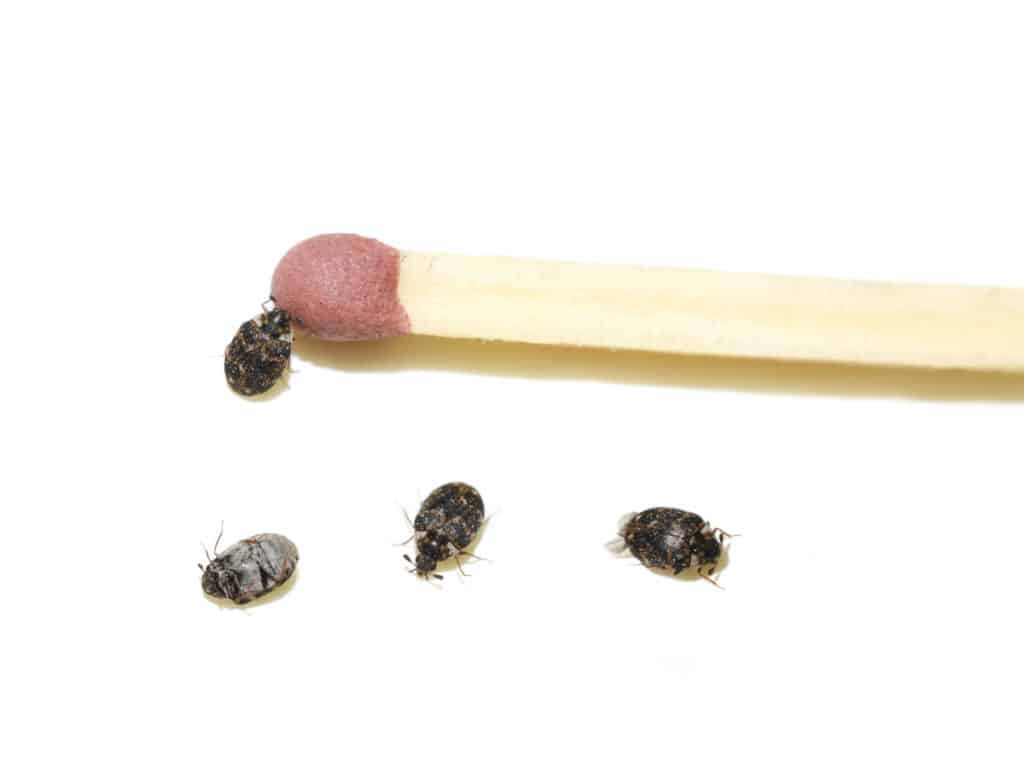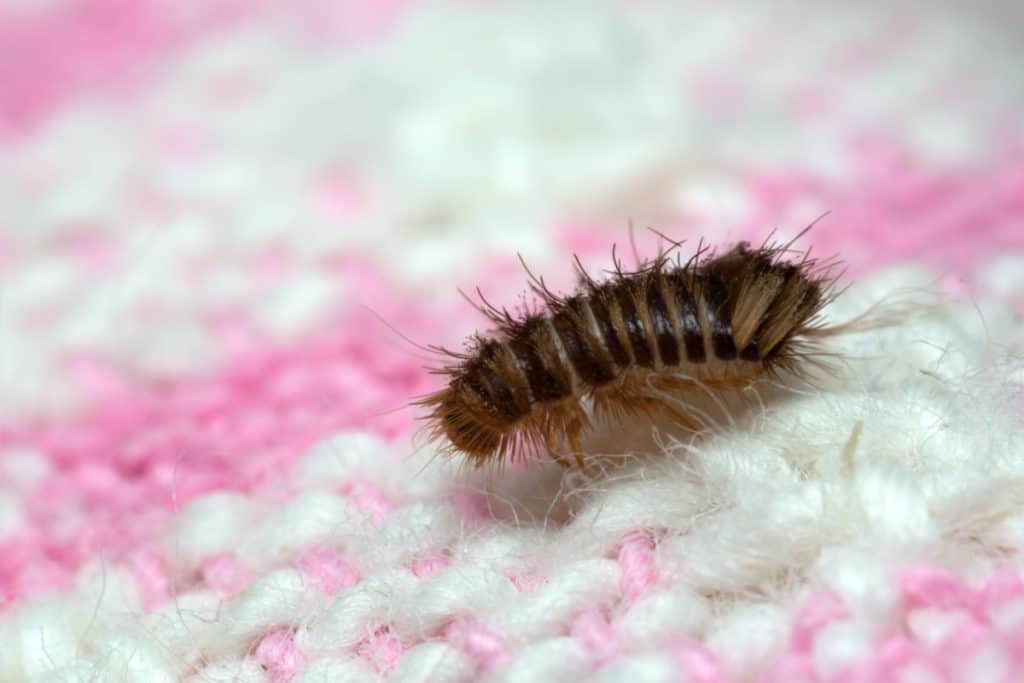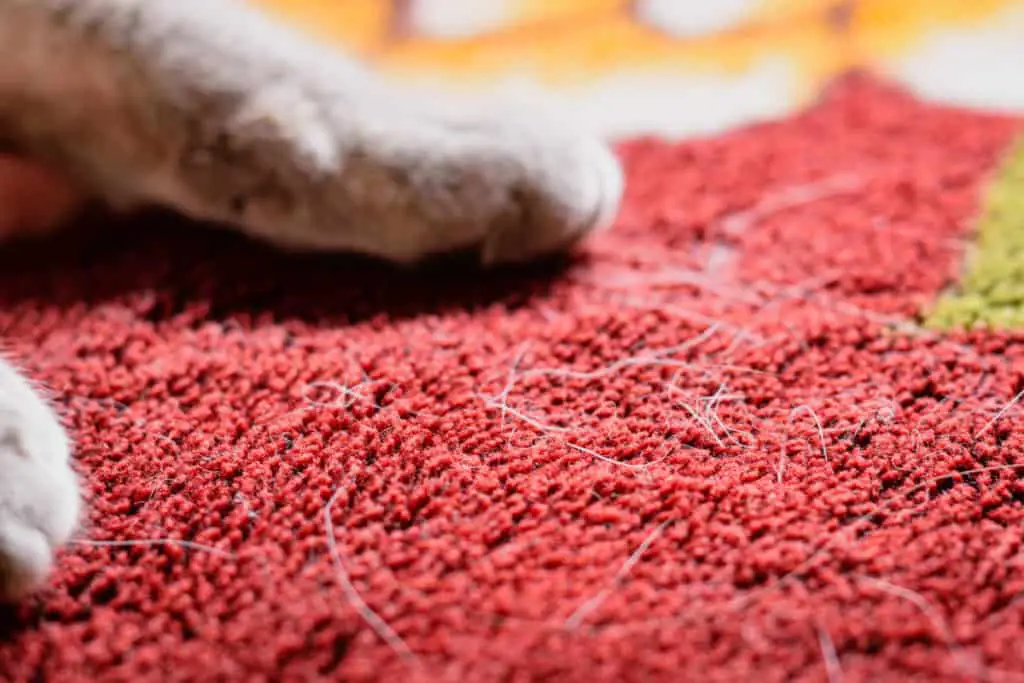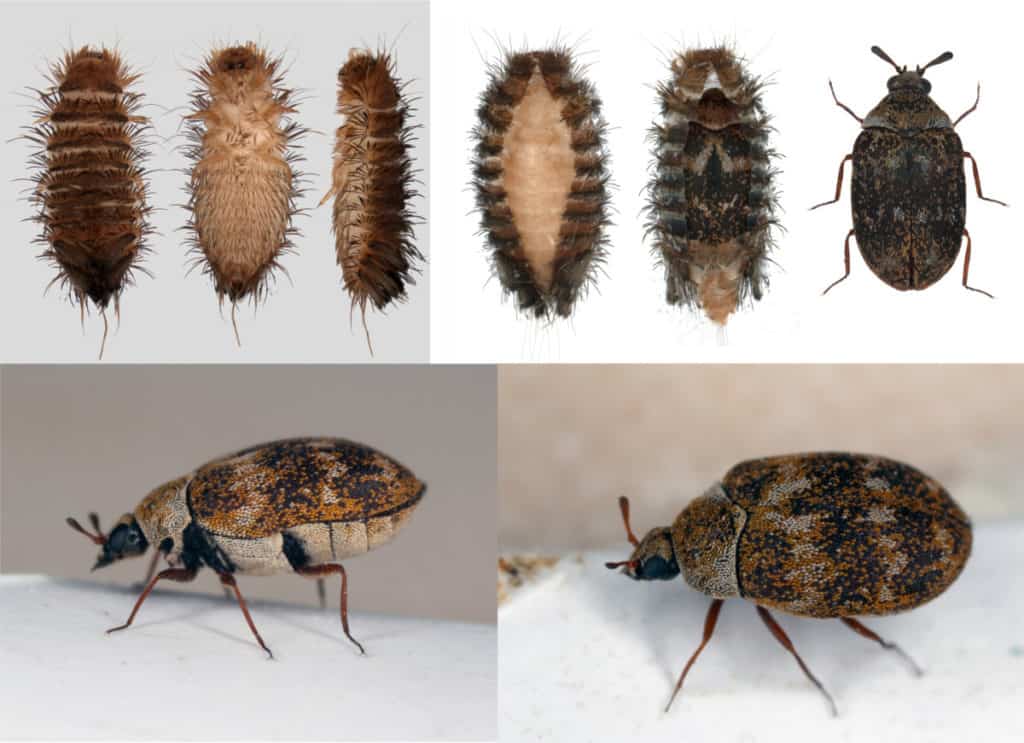Carpet beetles! You would think that their name implies what exactly are they, but not quite. One would think they live under carpets and eat the fibers- but the pesky critter doesn’t just like carpets- they favor all kinds of materials, and you can find them in other areas too.
As a general rule, homes left unattended for a long time, storing clothes in a closet or basement, and not cleaning rooms carefully can cause carpet beetles. Carpet beetle larvae chew wool items such as clothes, rugs, and furniture. They fly inside through doors or windows and lay eggs in dark areas.
You surely don’t want these tiny, hideous creatures in your home, chewing through your valuables. So, keep reading to learn how you can get rid of them, or even better, prevent them from coming in at all.
What Do Carpet Beetles Look Like?
Adult carpet beetles range from 1 mm to 3 mm and have an oval-shaped body and come in different colors, including black, white, brown, yellow, and sometimes orange.

The worm-like larvae are often larger than the adults, usually ranging from 3 mm to 6 mm, and are light brown to black. Their body is covered in dense bristly hair, making them irritating to the human skin. There are three distinct golden hairs on their abdomen. Since they prefer to live in dark places, they’re usually hard to spot.

The oval-shaped eggs are smaller than 1 mm and come in white or cream. You can find them in places like closets, air ducts, and piles of lint. It’s hard to see them in this stage of life because they blend in with their environments.
Why Do Carpet Beetles Damage Carpets?
Carpet beetle larvae are usually the ones to blame for damage to your stuff because of their diet. They eat natural fiber, specifically animal and plant-based materials such as wool, silk, feather, and leather. They also enjoy dead insects and all kinds of animal hair like felt or fur.

These materials contain an animal protein called keratin, which is easy to digest for the larvae. They don’t usually eat cotton or synthetic fabrics such as polyester and rayon unless mixed with wool or contain food stains and body oils.
Adult carpet beetles, on the other hand, eat seeds, plants, and flowers. They feed on pollen instead of fabric, so they’re unlikely to damage anything. They live both indoors and outdoors, but the females choose a place with lots of larval food sources when laying eggs. Under the carpet is one of their favorite places.
We know that carpet beetles like animal hair, but would they bite animals? We have done the research and written an article called, Do Carpet Beetles Bite Dogs?
Carpet Beetle Life Cycle And Reproduction
A carpet beetle’s life cycle usually starts in spring, when the female carpet beetle lays 25 to 100 eggs. About two weeks later, the eggs hatch into larvae. They grow up in almost any temperature and humidity level, but bright places aren’t their favorites.
A dark closet full of wool items, baseboards filled with a mass of pet hair, air vents, and ducts are the perfect environments for them to grow.
It takes more than a year for the larvae to mature, depending on food and climate. The nymphs shed their brown skin while growing up.
How Did I Get Carpet Beetles?
If left unattended, your home could turn into a breeding ground for carpet beetle larvae. The adults fly in and lay eggs on your furniture, curtain, clothes, or rugs. You may also bring them in when you bring in new plants, flowers, or pets. Walls, chimneys, or even inside birds’ nests can be a home for them too.
If you don’t clean your home regularly, the eggs may hatch and start a new cycle. Besides, lack of light is an invitation for carpet beetles. Open the curtains and windows every once in a while to let sunlight and air in the house.
If you find you have carpet beetle in your house the next question you might have is are they dangerous to the health of my family. We have written a detailed article about this specifically. Check it out if you are interested, Are Carpet Beetles Harmful?
How Can You Prevent Carpet Beetles?
The best way to deal with carpet beetles is to prevent them from infesting your house in the first place.
To do this, you should make it harder for them to grow. Clean your home regularly; vacuum the floor and carpet edges, and carefully dust all the corners.
If you plan to store woolen items and other vulnerable stuff for a long time, dry clean them first. Cleaning kills eggs or larvae and removes the perspiration odor which tempts these pests. Then put the clean items in an airtight plastic bag or container.
If you want to use mothballs, flakes, or crystals, read and follow the label directions to get the best results. These products contain chemicals that can be dangerous if misused. Never use them on open closets or areas reachable for children or pets.
You can protect your expensive clothes such as fur by keeping them in cold vaults, a service available in some department stores.
Some people believe cedar closets are effective in stopping pests, but it’s not true. The seal can’t keep deadly or repellent concentrations of cedar’s evaporative oil.
Hang sticky flypaper strips near your windows to stop adult beetles from entering. If you see any infestation, put sticky traps in your closets and on windows to catch them before they lay eggs.
How Can You Recognize Carpet Beetles?
You often identify the problem by seeing a group of adults around lights and windows. You might also see them flying around or crawling on surfaces.

However, You usually notice their presence when it’s too late, and they have caused damage to clothes, bedding, carpet, and furniture. They chew holes on objects and leave their shed skin behind.
Do carpet beetles poop? Can you tell if you have carpet beetles by poop they might leave behind? We have the answers in another detailed article we have written called, Do Carpet Beetles Poop And What Does It Look Like?
How Can You Get Rid Of Carpet Beetles?
Find Them
The first step is finding all the infested items and the primary source. Search for a rarely-used wool or fur piece of clothes in a closet. Pay attention to seams and folds, such as collars and cuffs.
Check for a carpet in the basement or the remains of a dead animal in your chimney or attic. Investigate all dark areas where you store things. Check the lower edges of rugs, wall edges, and baseboards. Also you should check the beds in your house.
Then move on to areas where you might find dead insects, upholstered furniture, or inside the vents and ducts filled with pet hair and lint.
Go into your kitchen to see plant-based foods kept in your home, such as cereal, pet food, and birdseed. You might even discover a rodent infestation that’s attracting carpet beetles since rodents tend to steal and pile up this stuff.
If you are looking for carpet beetles and fin little red bugs, then you might have another problem. You might have clover mites in your house. Find out if these clover mites can be harmful to you and your family. We have written an article called, Are Clover Mites Harmful?
Remove Them
After finding the infested items, launder, dry-clean, or even throw them away. Before discarding each item, make sure you bag it to stop the beetle from spreading. Washing with hot water and dry-cleaning kills the eggs or larvae. Clothes dryers’ heat generators are also helpful.
Since carpet beetle infestations spike during the spring, it’s an excellent excuse to start spring cleaning. So have a duster, vacuum, and broom to remove the dust, spider webs, and dead insects.
Vacuum the floors, carpets, and even inside the vents to remove larvae, eggs, and dust. To prevent future infestations, vacuum under the carpets, along baseboards, under the furniture, and stored items. Then move on to the closets and dark areas where carpet beetles like to feed.
Is it dangerous to touch carpet beetles? Will carpet beetles bite you? These are questions we have answered in another article if you are interested. It’s called, Do Carpet Beetles Bite?
Use Pest Control Products
Insecticides or pesticides are also an option added to good hygiene. Apply them to infested areas but don’t use them on clothes and bedding, though.
Boric acid is poisonous to insects. It prevents them from digesting their food, causing them to starve to death. You can find it in pharmacies and sprinkle the powder on your carpet. Use a broom to distribute it and wait several hours. Finally, vacuum the whole carpet. However, you need to be extra careful. Inhaling or ingesting boric acid can cause nausea, diarrhea, and stomach pain.
Diatomaceous earth is a natural product that kills larvae by dehydrating them. It’s available in agricultural stores. Use it the same as boric acid on rugs, and sprinkle it behind closets, beds, and cabinets. Wear a mask while using it to avoid inhaling the dust.
You can also use an insect fogger to eradicate adult beetles before they lay eggs and start that disgusting cycle again.
The Wrap Up
Carpet beetles pass three stages in their lives: egg, larva, and adult. Only larvae damage wool items such as carpets and clothes. However, noticing the adults in your home warns of future troubles because they lay eggs and the larvae hatch in two weeks.
Carpet beetles love dark areas, and they feed on wool carpets, clothes, and furniture. You should keep an eye on these areas, especially if you store something for a long time. The easiest way to prevent infestation is to regularly clean your home, especially under the rugs, in basements, closets, and dusty baseboards.
If an infestation does occur, use boric acid or diatomaceous earth to get rid of them.
Sources
https://www.orkin.com/other/beetles/carpet-beetles
https://entomology.ca.uky.edu/ef601
https://www.bobvila.com/articles/how-to-get-rid-of-carpet-beetles/
https://www.pestdefence.co.uk/news/how-to-get-rid-of-carpet-beetles/
http://npic.orst.edu/factsheets/boricgen.htm
https://www.sciencedirect.com/science/article/abs/pii/S0048357505000660
